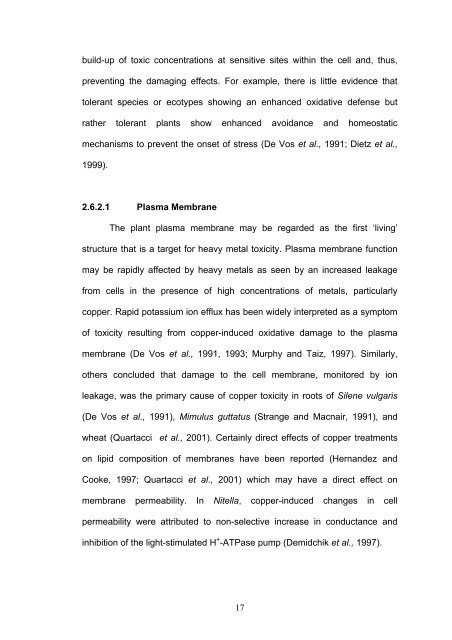IDENTIFICATION OF COPPER-INDUCIBLE GENES IN Pistia stratiotes
IDENTIFICATION OF COPPER-INDUCIBLE GENES IN Pistia stratiotes
IDENTIFICATION OF COPPER-INDUCIBLE GENES IN Pistia stratiotes
You also want an ePaper? Increase the reach of your titles
YUMPU automatically turns print PDFs into web optimized ePapers that Google loves.
uild-up of toxic concentrations at sensitive sites within the cell and, thus,<br />
preventing the damaging effects. For example, there is little evidence that<br />
tolerant species or ecotypes showing an enhanced oxidative defense but<br />
rather tolerant plants show enhanced avoidance and homeostatic<br />
mechanisms to prevent the onset of stress (De Vos et al., 1991; Dietz et al.,<br />
1999).<br />
2.6.2.1 Plasma Membrane<br />
The plant plasma membrane may be regarded as the first ‘living’<br />
structure that is a target for heavy metal toxicity. Plasma membrane function<br />
may be rapidly affected by heavy metals as seen by an increased leakage<br />
from cells in the presence of high concentrations of metals, particularly<br />
copper. Rapid potassium ion efflux has been widely interpreted as a symptom<br />
of toxicity resulting from copper-induced oxidative damage to the plasma<br />
membrane (De Vos et al., 1991, 1993; Murphy and Taiz, 1997). Similarly,<br />
others concluded that damage to the cell membrane, monitored by ion<br />
leakage, was the primary cause of copper toxicity in roots of Silene vulgaris<br />
(De Vos et al., 1991), Mimulus guttatus (Strange and Macnair, 1991), and<br />
wheat (Quartacci et al., 2001). Certainly direct effects of copper treatments<br />
on lipid composition of membranes have been reported (Hernandez and<br />
Cooke, 1997; Quartacci et al., 2001) which may have a direct effect on<br />
membrane permeability. In Nitella, copper-induced changes in cell<br />
permeability were attributed to non-selective increase in conductance and<br />
inhibition of the light-stimulated H + -ATPase pump (Demidchik et al., 1997).<br />
17








![[Consumer Behaviour] - ePrints@USM](https://img.yumpu.com/21924816/1/184x260/consumer-behaviour-eprintsusm.jpg?quality=85)








